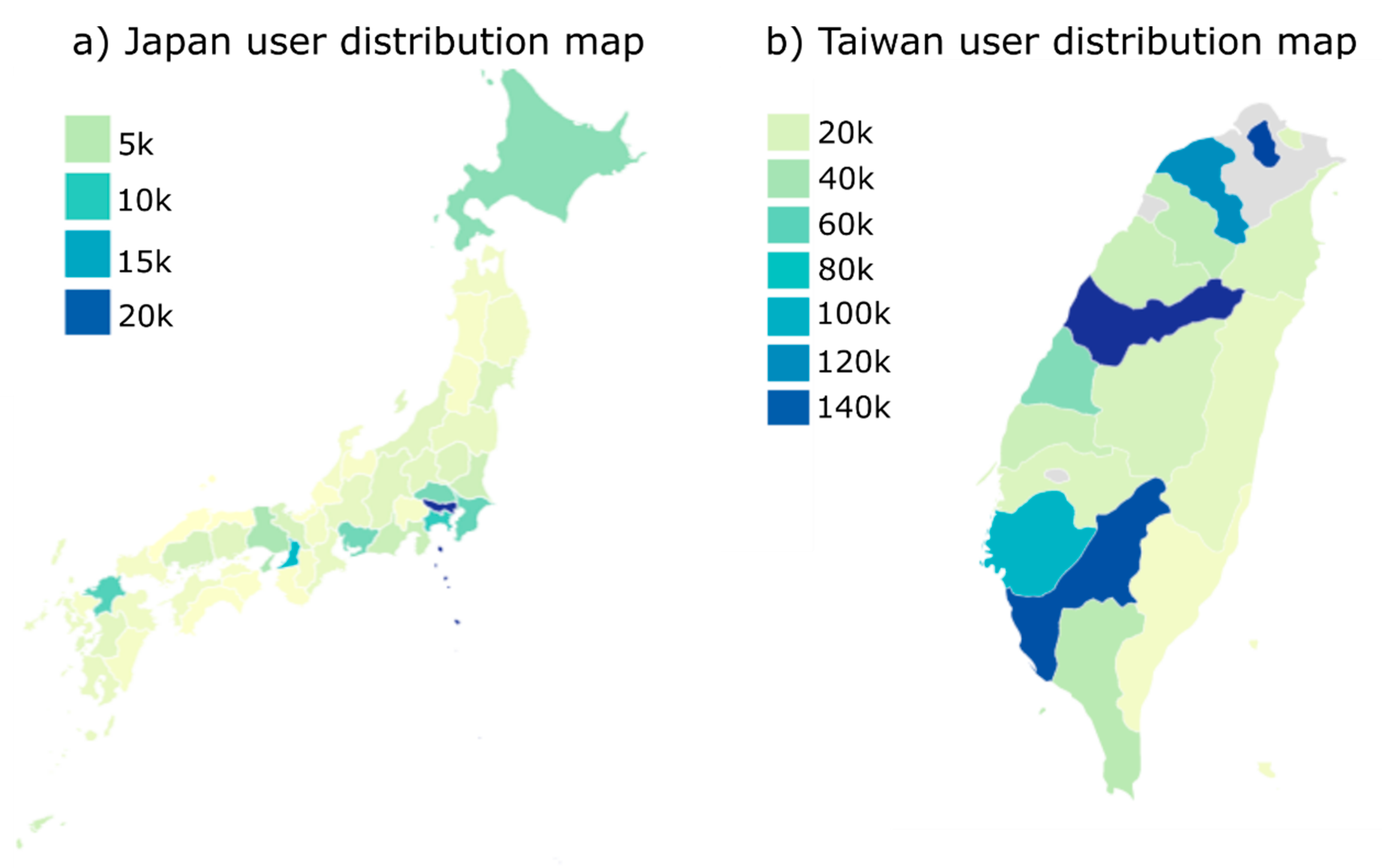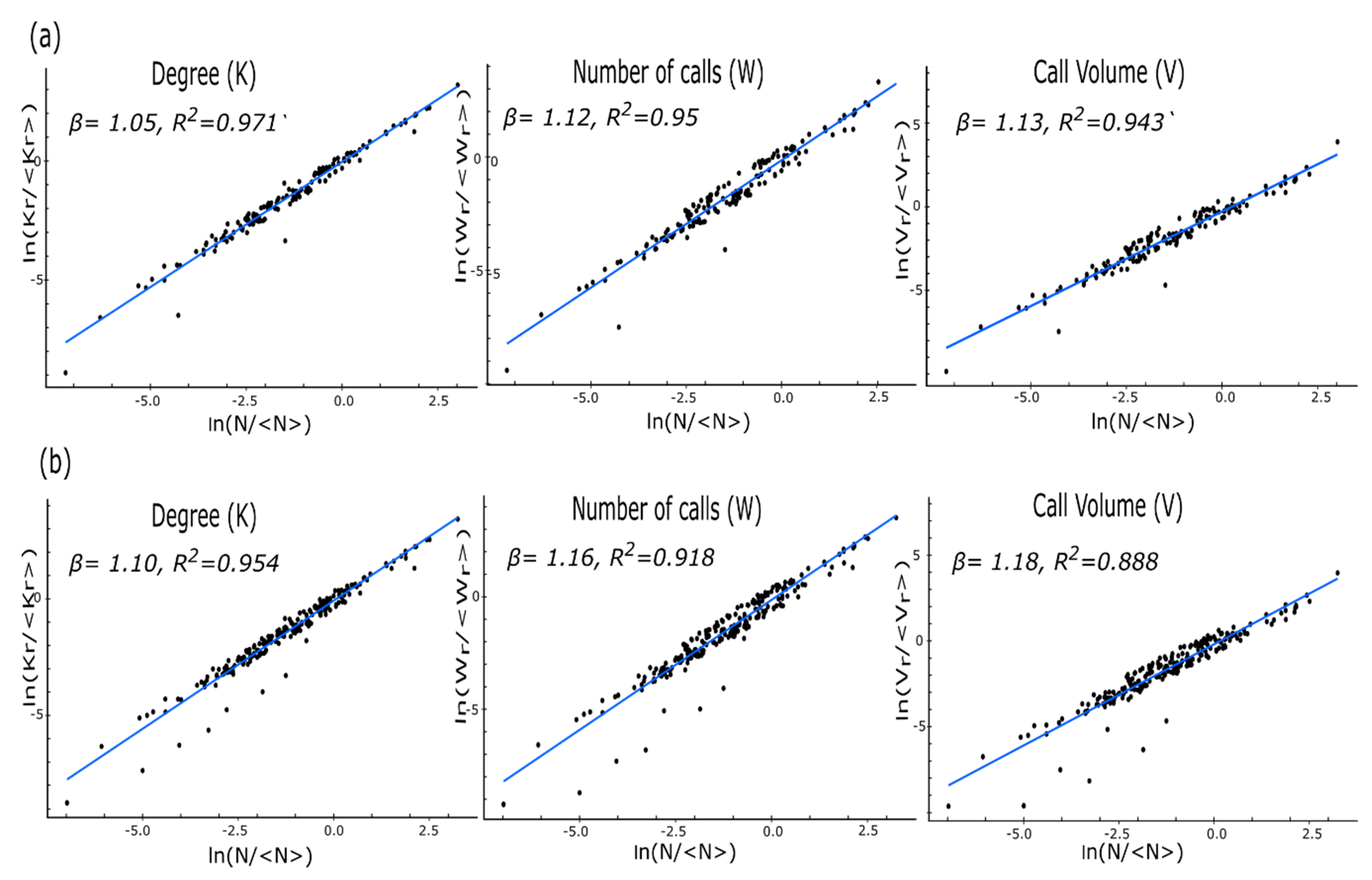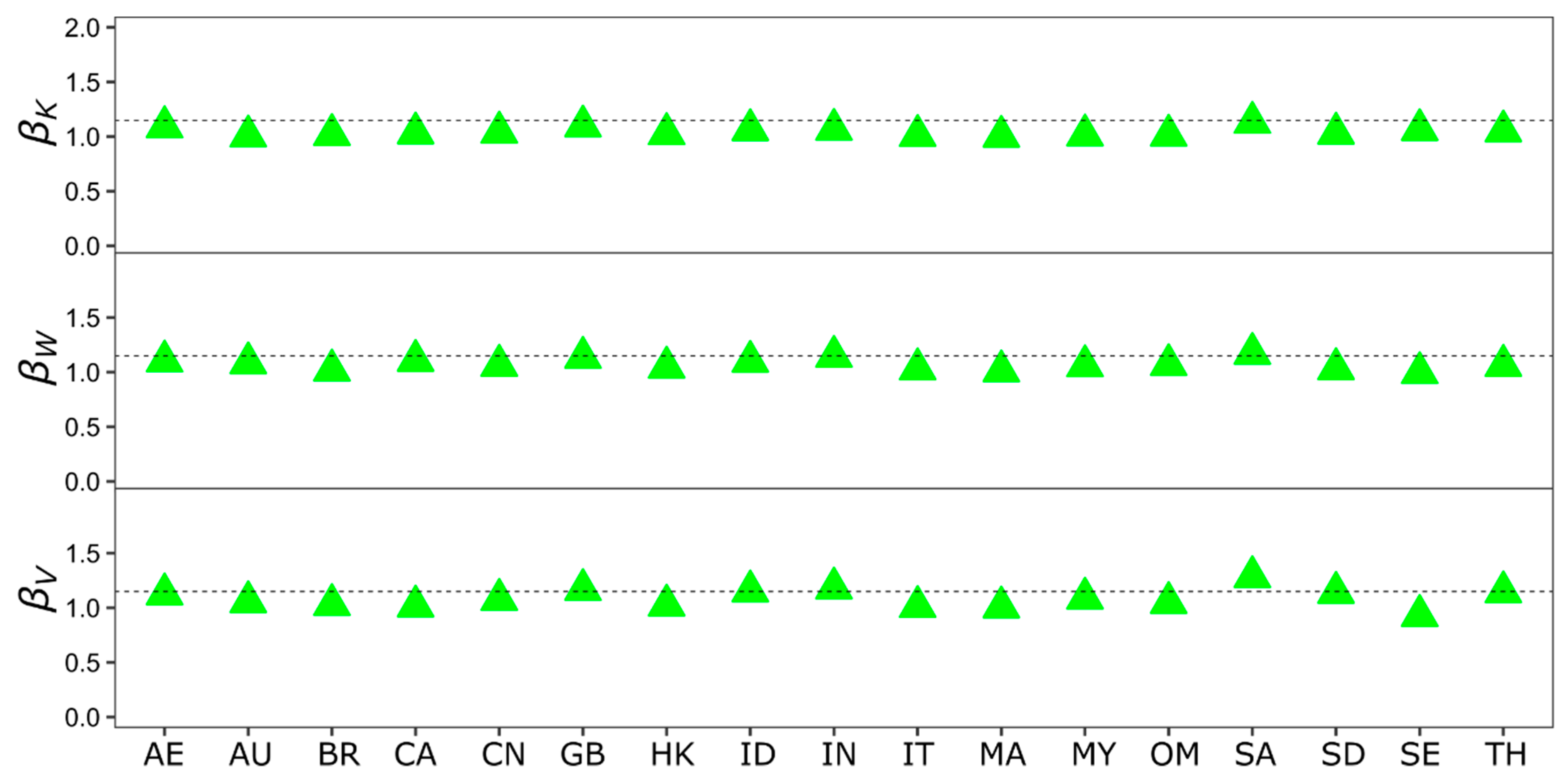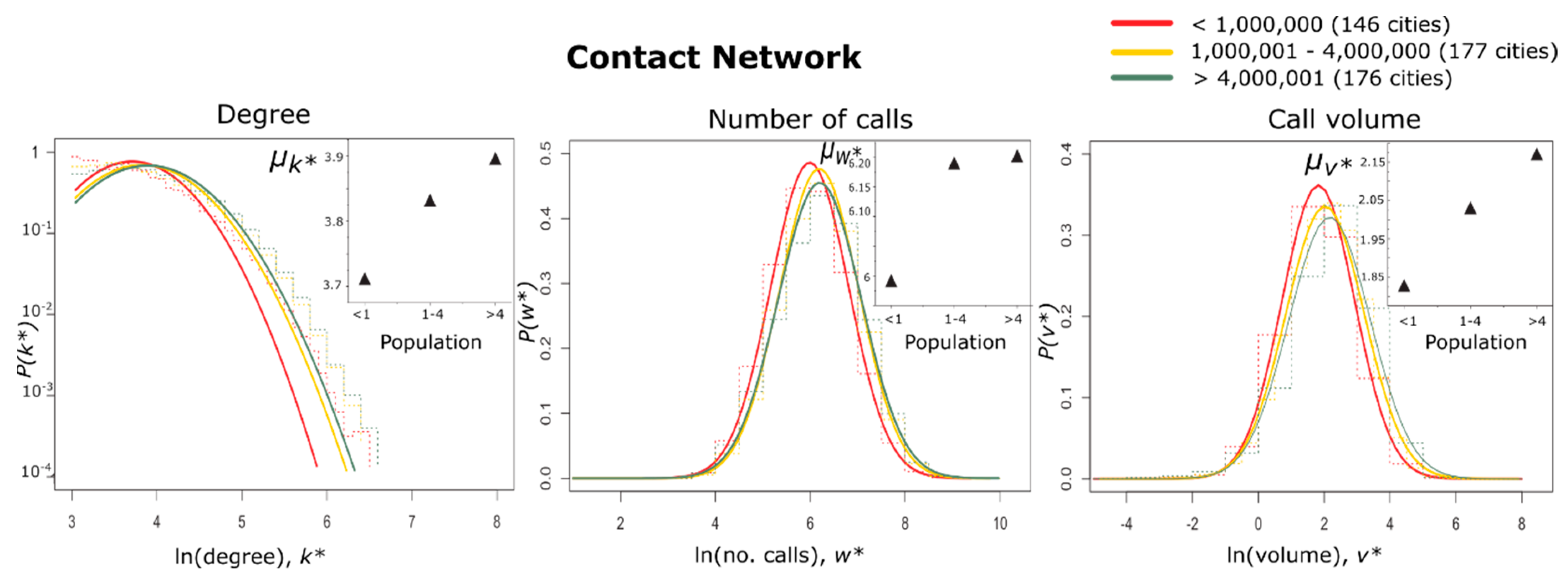Social Interaction Scaling for Contact Networks
Abstract
:1. Introduction
2. Materials and Methods
2.1. Whoscall Data
- Data filtering: The first step involved the conventional filtering procedure of removing irrelevant and spam entries, then generating complete and consistent information. It is important to test the structural robustness of networks as missing data can cripple the functionality and stability of the entire network. A seminal work studies the subgraph robustness against different attacks and for different network topologies, which is helpful in understanding aptly the resilience of many real-world networks since data missing is prevalent in such systems [38].
- Data location query: This step aimed at identifying the location of the base station on Google Maps. With the help of cell ID (CID) sets available in the data, we identified the location of the cell towers that routed the users’ calls. This data contained information including the unique identifier of the cell, location area code, mobile network code, and the cell tower’s mobile country code. This information was inputted into the Google Maps Geolocation API to query the geographic coordinates (latitude and longitude) by translating the CID sets. Later, the Reverse Geocoding Google API (application programming interface) was used to convert the extracted coordinates into a human-readable address. This was helpful in identifying the location of a user.
- Data extraction: The third and final preprocessing step mapped the acquired location and information to each user and extracted the communication details.
2.2. Connectivity Parameters
- Nodal degree k: The total number of nodes or contacts each user is linked with. As per egocentric definition, this is the number of links to alters by an ego.
- Call frequency w: The number of calls initiated or received by each user. Frequency only considers calls from the contacts the user has in his or her phone and excludes unknown calls.
- Call volume v: The time a user spent on the phone; the duration of the call.
2.3. Contact Networks
3. Results
3.1. Social Connectivity Scaling Property at the Collective Level
Findings
3.2. Social Connectivity Scaling Property at the Individual Level
3.2.1. Generalized Distributions for Individual Social Connectivity
3.2.2. City Bins
3.2.3. Population Impact on Individual Connectivity
4. Discussion
5. Conclusions
Author Contributions
Funding
Conflicts of Interest
References
- Florida, R. Cities and the Creative Class; Routledge: New York, NY, USA, 2004. [Google Scholar]
- Pumain, D.; Paulus, F.; Vacchiani-Marcuzzo, C.; Lobo, J. An evolutionary theory for interpreting urban scaling laws. Cybergeo 2006, 343, 1–20. [Google Scholar] [CrossRef]
- World Urbanization Prospects: The 2018 Revision-Highlights; United Nations: New York, NY, USA, 2018.
- Batty, M. A Theory of city size. Science 2013, 340, 1418–1419. [Google Scholar] [CrossRef] [PubMed]
- Bettencourt, L.M.A.; Lobo, J.; Helbing, D.; Kühnert, C.; West, G.B. Growth, innovation, scaling, and the pace of life in cities. Proc. Natl. Acad. Sci. USA 2007, 104, 7301–7306. [Google Scholar] [CrossRef]
- Bettencourt, L.M.A. The origins of scaling in cities. Science 2013, 340, 1438–1441. [Google Scholar] [CrossRef]
- Bettencourt, L.M.A.; Lobo, J.; Strumsky, D.; West, G.B. Urban scaling and Its deviations: Revealing the structure of wealth, innovation and crime across cities. PLoS ONE 2010, 5, e13541. [Google Scholar] [CrossRef]
- Batty, M. The New Science of Cities; The MIT Press: Cambridge, MA, USA, 2013; p. 520. [Google Scholar]
- Arbesman, S.; Kleinberg, J.M.; Strogatz, S.H. Superlinear Scaling for Innovation in Cities. Phys. Rev. E 2009, 79, 1–5. [Google Scholar] [CrossRef] [PubMed]
- Bettencourt, L.M.A.; Lobo, J.; Strumsky, D.; West, G.B. Urban scaling and the production function for cities. PLoS ONE 2013, 8, e58407. [Google Scholar]
- Büchel, K.; von Ehrlich, M. Cities and the Structure of Social Interactions: Evidence from Mobile Phone Data; CESifo Working Paper: Munich, Germany, 2017. [Google Scholar]
- Strano, E.; Sood, V. Rich and poor cities in Europe. An urban scaling approach to mapping the European economic transition. PLoS ONE 2016, 11, e0159465. [Google Scholar] [CrossRef]
- Alves, L.G.A.; Ribeiro, H.V.; Mendes, R.S. Scaling laws in the dynamics of crime growth rate. Physica A 2013, 392, 2672–2679. [Google Scholar] [CrossRef]
- Oliveira, M.; Bastos-Filho, C.; Menezes, R. The scaling of crime concentration in cities. PLoS ONE 2017, 12, e0183110. [Google Scholar] [CrossRef] [PubMed]
- Tizzoni, M.; Sun, K.; Benusiglio, D.; Karsai, M.; Perra, N. The scaling of human contacts and epidemic processes in metapopulation networks. Sci. Rep. 2015, 5, 15111. [Google Scholar] [CrossRef]
- Bettencourt, L.M.A.; Lob, J.; Youn, H. The hypothesis of urban scaling: Formalization, implications and challenges. arXiv 2013, arXiv:1301.5919. [Google Scholar]
- Bettencourt, L.M.A.; Lobo, J.; West, G.B. Why are large cities faster? Universal scaling and self-similarity in urban organization and dynamics. Eur. Phys. J. B 2008, 63, 285–293. [Google Scholar] [CrossRef]
- Batty, M. The Size, Scale, and Shape of Cities. Science 2008, 319, 769–771. [Google Scholar] [CrossRef]
- Bettencourt, L.M.A.; West, G. A unified theory of urban living. Nature 2010, 467, 912–913. [Google Scholar] [CrossRef] [PubMed]
- Li, R.; Dong, L.; Wang, X.; Wang, W.-X.; Di, Z.; Stanley, H.E. Simple spatial scaling rules behind complex cities. Nat. Commun. 2017, 8, 1841. [Google Scholar] [CrossRef]
- Keeling, M.J.; Rohani, P. Modeling Infectious Diseases in Humans and Animals; Princeton Univeristy Press: Princeton, NJ, USA, 2008. [Google Scholar]
- Pan, W.; Ghoshal, G.; Krumme, C.; Cebrian, M.; Pentland, A. Urban characteristics attributable to density-driven tie formation. Nat. Commun. 2013, 4, 1961. [Google Scholar] [CrossRef]
- Rybski, D.; Buldyrev, S.V.; Havlin, S.; Liljeros, F.; Makse, H.A. Scaling laws of human interaction activity. Proc. Natl. Acad. Sci. USA 2009, 106, 12640–12645. [Google Scholar] [CrossRef]
- Sveikauskas, L. The productivity of cities. Q. J. Econ. 1975, 89, 393–413. [Google Scholar] [CrossRef]
- Charlot, S.; Duranton, G. Communication Externalities in Cities. J. Urban Econ. 2004, 56, 581–613. [Google Scholar] [CrossRef]
- Jessica, B. The Built Environment and Social Interactions: Evidence from Panel Data. Available online: https://www.sauder.ubc.ca/Faculty/Research_Centres/Centre_for_Urban_Economics_and_Real_Estate/News_and_Events/~/media/Files/Faculty%20Research/3%20SunBurleySocialInteractionsUBC%201.ashx (accessed on 30 May 2015).
- Schlapfer, M.; Bettencourt, L.M.A.; Grauwin, S.; Raschke, M.; Claxton, R.; Smoreda, Z.; West, G.B.; Ratti, C. The scaling of human interactions with city size. J. R. Soc. Interface 2014, 11. [Google Scholar] [CrossRef]
- Herrera-Yagüe, C.; Schneider, C.M.; Couronné, T.; Smoreda, Z.; Benito, R.M.; Zufiria, P.J.; González, M.C. The anatomy of urban social networks and its implications in the searchability problem. Sci. Rep. 2015, 5, 10265. [Google Scholar] [CrossRef]
- Miritello, G.; Lara, M.; Cebrian, M.; Moro, M. Limited communication capacity unveils strategies for human interaction. Sci. Rep. 2013, 3, 1950. [Google Scholar] [CrossRef]
- Saramäki, J.; Leicht, E.; López, E.; Roberts, S.; Reed-Tsochas, F.; Dunbar, R. Persistence of social signatures in human communication. Proc. Natl. Acad. Sci. USA 2014, 111, 942–947. [Google Scholar] [CrossRef]
- Jacobs, J. The Death and Life of Great American Cities; Random House: New York, NY, USA, 1961. [Google Scholar]
- Wirth, L. Urbanism as a way of life. Am. J. Sociol. 1938, 44, 1–24. [Google Scholar] [CrossRef]
- O’Malley, A.J.; Arbesman, S.; Steiger, D.M.; Fowler, J.H.; Christakis, N.A. Egocentric Social network structure, health, and pro-social behaviors in a national panel study of Americans. PLoS ONE 2012, 7, e36250. [Google Scholar] [CrossRef]
- Blondel, V.D.; Decuyper, A.; Krings, G. A survey of results on mobile phone datasets analysis. EPJ Data Sci. 2015, 4. [Google Scholar] [CrossRef]
- Deville, P.; Linard, C.; Martine, S.; Gilbert, M.; Stevensf, F.; Gaughanf, A.; Blondela, V.D.; Tatem, A.J. Dynamic population mapping using mobile phone data. Proc. Natl. Acad. Sci. USA 2014, 111, 15888–15893. [Google Scholar] [CrossRef]
- Seshadri, M.; Machiraju, S.; Sridharan, A.; Bolot, J.; Faloutsos, C.; Leskove, J. Mobile call graphs: Beyond power-law and lognormal distributions. In Proceedings of the 14th ACM SIGKDD, Las Vegas, NV, USA, 24–27 August 2008; pp. 596–604. [Google Scholar]
- Whoscall. Available online: https://whoscall.com/en-US/ (accessed on 17 January 2015).
- Shang, Y. Subgraph robustness of complex networks under attacks. IEEE Trans. Syst. Man Cybern. Syst. 2019, 49, 821–832. [Google Scholar] [CrossRef]
- Shang, Y. Consensus in averager-copier-voter networks of moving dynamical agents. Chaos 2017, 27, 023116. [Google Scholar] [CrossRef]
- Arcaute, E.; Hatna, E.; Ferguson, P.; Youn, H.; Johansson, A.; Batty, M. Constructing cities, deconstructing scaling laws. J. R. Soc. Interface 2015, 12. [Google Scholar] [CrossRef]
- Cottineau, C.; Hatna, E.; Arcaute, E.; Batty, M. Paradoxical interpretations of urban scaling laws. arXiv 2015, arXiv:1507.07878. [Google Scholar]
- Second-Level Administrative Country Subdivisions. Available online: http://www.fao.org/geonetwork/srv/en/metadata.show?id=12691&currTab=simple (accessed on 10 March 2016).
- Baumeister, R.; Leary, M. The need to belong: Desire for interpersonal attachments as a fundamental human motivation. Psychol. Bull. 1995, 117, 497–529. [Google Scholar] [CrossRef] [PubMed]
- Kawamichi, H.; Sugawara, S.K.; Hamano, Y.H.; Makita, K.; Kochiyama, T.; Sadato, N. Increased frequency of social interaction is associated with enjoyment enhancement and reward system activation. Sci. Rep. 2016, 6, 24561. [Google Scholar] [CrossRef] [PubMed]
- Holt-Lunstad, J.; Timothy, B.S.; Layton, J.B. Social relationships and mortality Risk: A meta-analytic review. PLoS Med. 2010, 7, e1000316. [Google Scholar] [CrossRef] [PubMed]
- Glaeser, E. Cities, productivity, and quality of Life. Science 2011, 333, 592–594. [Google Scholar] [CrossRef]
- Glaeser, E.L. Learning in cities. J. Urban Econ. 1999, 46, 254–277. [Google Scholar] [CrossRef]
- Shang, Y. Distinct clusterings and characteristic path lengths in dynamic small-world networks with Identical limit degree distribution. J. Stat. Phys. 2012, 149, 505–518. [Google Scholar] [CrossRef]





© 2019 by the authors. Licensee MDPI, Basel, Switzerland. This article is an open access article distributed under the terms and conditions of the Creative Commons Attribution (CC BY) license (http://creativecommons.org/licenses/by/4.0/).
Share and Cite
Ghafoor, Y.; Chen, Y.-S.; Chen, K.-T. Social Interaction Scaling for Contact Networks. Sustainability 2019, 11, 2545. https://doi.org/10.3390/su11092545
Ghafoor Y, Chen Y-S, Chen K-T. Social Interaction Scaling for Contact Networks. Sustainability. 2019; 11(9):2545. https://doi.org/10.3390/su11092545
Chicago/Turabian StyleGhafoor, Yusra, Yi-Shin Chen, and Kuan-Ta Chen. 2019. "Social Interaction Scaling for Contact Networks" Sustainability 11, no. 9: 2545. https://doi.org/10.3390/su11092545
APA StyleGhafoor, Y., Chen, Y.-S., & Chen, K.-T. (2019). Social Interaction Scaling for Contact Networks. Sustainability, 11(9), 2545. https://doi.org/10.3390/su11092545




